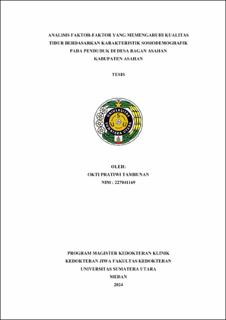| dc.description.abstract | Background: Sleep problems are one of the leading causes of disease burden globally. According
to the National Sleep Foundation about 37% of American adults report poorer sleep by 2023 than
in previous years. Bagan Asahan Village, Tanjung Balai Subdistrict, which is a disadvantaged
area with limited health access, there is no adequate data regarding the quality of community
sleep. Ismah (2021) has conducted research in Deli Serdang Regency Rural residents are 1.5
times more likely to experience poor sleep quality. However, no research has examined what
factors can affect poor sleep quality in disadvantaged villages. This study aims to analyze the
sleep quality of villagers and the sociodemographic factors that influence it.
Methods: This study used a multivariate analytic design with a cross-sectional approach. The
sample was randomly drawn using a cluster sampling approach, involving 308 individuals aged
19 to 59 years in Bagan Asahan Village. Sleep quality was measured using the Pittsburgh Sleep
Quality Index (PSQI), Data analysis used logistic regression to assess the association between
independent variables, such as age, gender, education, smoking, and coffee consumption, and the
dependent variable, sleep quality.
Results: Of the 308 participants, 47.1% had poor sleep quality. Bivariate analysis showed
significant associations between education (p=0.025), smoking (p=0.001), and coffee consumption
(p<0.001) with sleep quality. Individuals with low education had a 4.40 times higher risk of
experiencing poor sleep quality than those with higher education. The Hosmer-Lemeshow test
showed a p=0.921, indicating a good logistic regression model, while the Area Under Curve
(AUC) value of 62.6% indicated the model's ability to distinguish individuals with good and poor
sleep quality.
Conclusion: This study concluded that the factors of education, smoking, and coffee consumption
have a significant influence on the quality of sleep in Bagan Asahan Village. No significant
relationship was found between gender, marital status, occupation, and income with sleep quality.
These findings emphasize the importance of more integrated health interventions and community
education on the negative impact of smoking and coffee consumption on sleep quality. In addition,
this study encourages the development of programs to | en_US |


